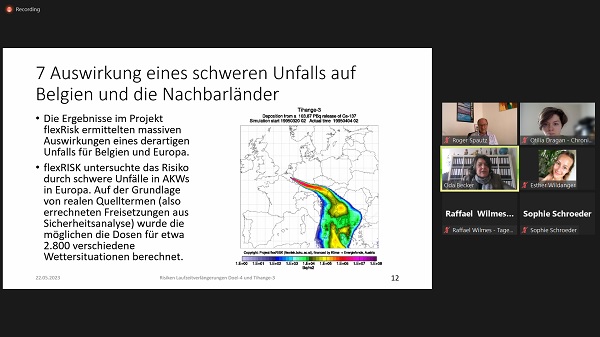 Credit: Screenshot from ZOOM/Chronicle.lu
Credit: Screenshot from ZOOM/Chronicle.lu
Greenpeace Luxembourg held a press videoconference on the morning of Monday 22 May 2023, presenting the analysis led by German and Austrian experts on the file published by the Belgian authorities as part of the public consultations on reactor life extension.
The nuclear plants at Doel 4 and Tihange 3 in Belgium will have reached their 40th anniversary in 2023, the period of operation for which they have been designed. The local government plans to extend their duration for ten years, despite safety standards no longer corresponding to the safety requirements observed for recent reactors, according to Greenpeace.
Between 30 March and 20 June 2023, the Luxembourg Ministry of the Environment, Climate and Sustainable Development is organising a cross-border consultation. The latter is compulsory for the Belgian Parliament to pass legislation on the two nuclear reactors’ life extension. All Luxembourg residents can express their opinion on this matter.
Oda Becker, physicist and scientific consultant for nuclear risks, who studied at the University of Hannover, one of the authors of the report, held a presentation about this topic during the press videoconference. Roger Spautz, one of the founders of Greenpeace Luxembourg, was present for the occasion to introduce the topic and answer questions.
The prolongation for the reactor’s life span would call for 810 nuclear fuel elements and an additional 1.2 km for nuclear waste storage, Oda Becker said. She stressed that the life prolongation of Doel-4 and Tihange-3 in Belgium requires another strategic environmental assessment. According to Oda Becker, this prolongation would be a “political decision” erroneously presented as “the only alternative.” In fact, she noted, the life prolongation of aged nuclear reactors often suppresses the development of new alternatives and brings with it considerable risks.
According to Greenpeace, the currently assessed risks and measures in the Environmental Impact Assesment documents can lead to intervention measures such as containment or the distribution of potassium iodine tablets. But the calculated accidents are by no means the most serious incidents possible. The flexRISK project, for instance, studied the possibility of a major disaster for both reactors: the results of the study show that large parts of Europe could be contaminated. Climate change and weather conditions need to be taken into account for this possible scenario (north-eastern areas from the nuclear reactors would be most likely heavily contaminated). Such an accident could even lead to evacuations of areas in Belgium and neighbouring countries.
The life prolongation of old nuclear reactors brings with it unexpected damages and the necessary changes brough to such reactors are often very limited, Oda Becker stressed. Examples would be the addition of air-cooling devices or humidifiers, added shielding and isolation but without necessary structural modifications, sometimes due to the fact that not all components of reactors can be exchanged.
Furthermore, she noted, both nuclear reactors are not sufficiently protected against terrorist attacks and/or sabotage acts. She reported that damages were found in the concrete of the Tihange-3 bunker area.
Roger Spautz added that this risk analysis will be published and brought to the attention of the Luxembourgish and German governments. “The population and political leaders have the right to know on which points Doel-4 and Tihange-3 do not meet current safety standards. Likewise, information on upgrades that are technically possible but held in abeyance for economic reasons must be disseminated in a clear and transparent way,” he said.








